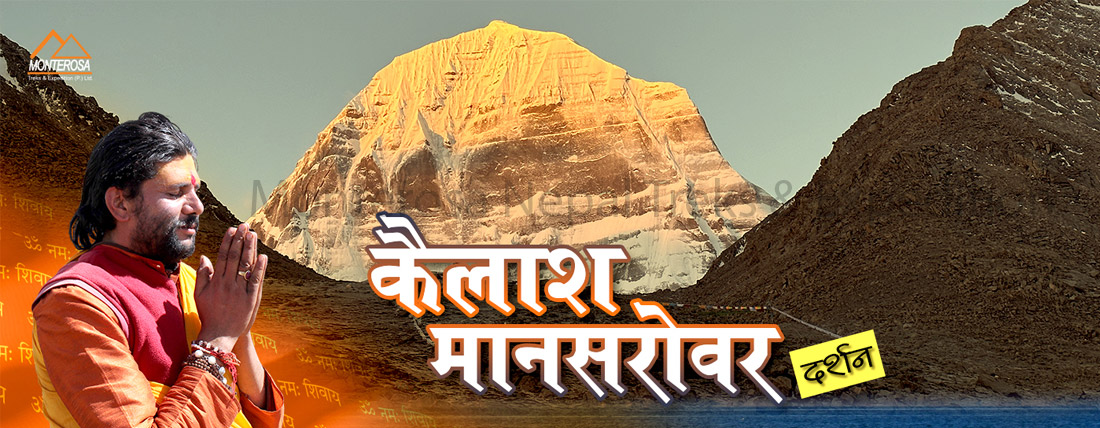
Kailash tour package Service provided by Monterosa Treks and Expedition Pvt. Ltd. for all devotees from around the world who traveling to Kailash Manasarovar Yatra in 2025 and 2026. For all Kailash Manasarovar devotees, we have the best Kailash tour package cost. Consider a 17-day Kailash Manasarovar tour from Kathmandu that includes visits to Mount Kailash and holy Lake Manasarovar, with options for overland by road, via Lhasa, Lhasa Kailash Manasarovar Lhasa and Ali route. This Mount Kailash pilgrimage takes you to the sacred Holy place Kailash and the enchanting Lake Manasarovar on an incredibly spiritual pilgrimage. This Yatra is regarded as the holiest journey to the divine abode of Lord Shiva, whose unique black granite form is worshipped here. Following Kailash tour package, Kailash is a sacred site for four major religions: Hinduism, Buddhism, Jainism and Bonpo.
Experience a divine pilgrimage to Mt. Kailash and holy Manasarovar Lake on the sacred Kailash Manasarovar Yatra tour. Thousands of pilgrims and devotees visit Mount Kailash and Lake Manasarovar every year because of their serene beauty and spiritual significance. It offers a transformative experience and a deeper understanding of life's purpose with Monterosa Treks and Expedition's Kailash tour package. It is filled with adventures, mystical temples, breathtaking landscapes and surreal views of snow-clad mountain. Kailash Mountain appears to resemble Shiva ling in the Kailash Manasarovar area, and we believe it makes a circle for the purpose of attaining spiritual salvation. For those seeking both spiritual fulfillment and natural wonder, Kailash Manasarovar Yatra is a dream destination. We are always happy to host your Kailash Manasarovar Yatra / Tour and any other holy places destination tour with Monterosa Treks & Expedition. The Holy Kailash Manasarovar Yatra is a great opportunity for us to introduce our company as a tour operator. Since its establishment in 1993, Monterosa Treks and Expedition has been run by professionals who specialize in Kailash Yatra, Trekking, Expeditions, tour leaders, and guides who speak English, Hindi and other international languages.
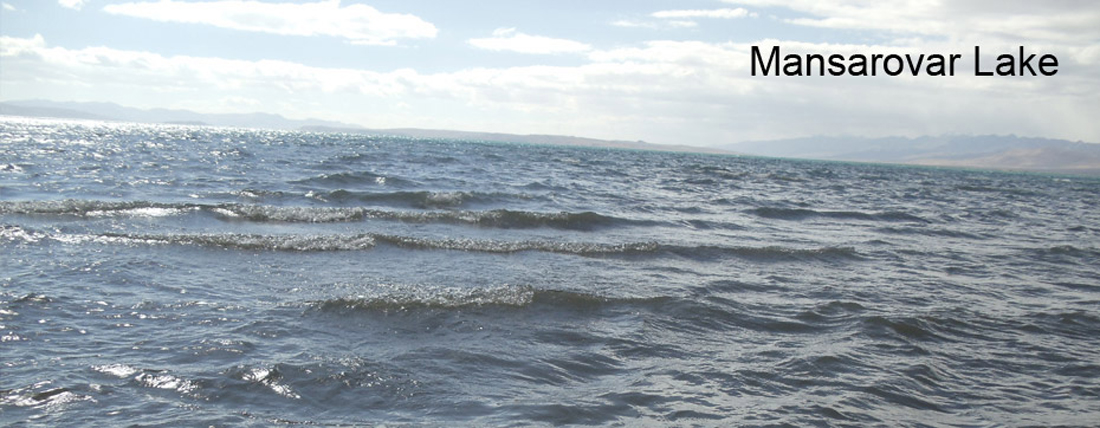
It is a lake of consciousness and enlightenment, the name Manasarovar meaning lake of consciousness and enlightenment. Lake Manasarovar, the word 'Manas' means mind or consciousness. In Hinduism and Buddhism, it holds great spiritual significance and is a source of deep spiritual influence. At a height of 4560 meters from sea level, it is one of the highest bodies of water on earth. One is believed to cleanse one's soul and body from sickness by making a loop around Manasarovar Lake and taking a dip in it. It is believed that taking a dip in the Manasarovar Lake can help one retain youth and vitality. Yet there are others who believe that one can not only clean one's soul, but also secure his place in heaven after death. Another school of thought holds that taking a dip in it leads to moksha (freedom from birth and rebirth). It takes 3 days for locals to walk around Manasarovar Lake, and it takes 5 days for pilgrims and adventure seekers to camp. Around the lake we can also see eight Buddhist monasteries, with Chiu Gompa monastery being one of the most popular. The Tibet lying Manasarovar Lake promises treasures of Shangri-La for all adventure travelers. We can see birds and wild ducks here. Visiting once this pilgrimage area and adventure paradise is a life time achievement.
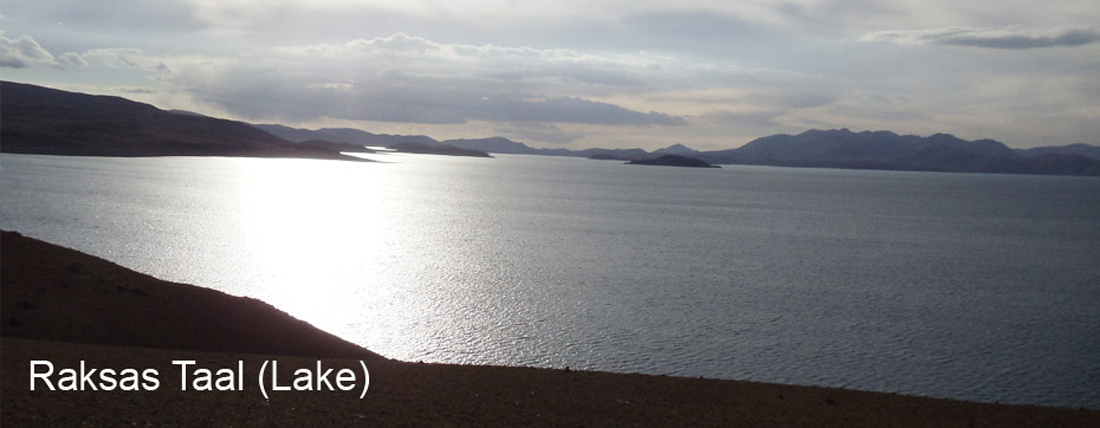 There is a legend that the water of Rakshas Tal is poisonous, because of the flesh-eating demons believed to lurk beneath its dark waters in Hindu mythology. This lake represents dark, malevolent forces, and pilgrims generally avoid its waters. Rakshas Tal was poisoned until a gold fish from Manasarovar Lake tunneled through a narrow isthmus to let sacred water flow in. Ravana is said to have performed penance in Rakshas Tal to invoke Lord Shiva. According to locals, it is not recommended to drink the water from this lake. Rakshas Tal is located 15 meters below Manasarovar Lake at 4545 meters above sea level in the western part of the lake. In this lake, there are no birds or wild ducks to be seen.
There is a legend that the water of Rakshas Tal is poisonous, because of the flesh-eating demons believed to lurk beneath its dark waters in Hindu mythology. This lake represents dark, malevolent forces, and pilgrims generally avoid its waters. Rakshas Tal was poisoned until a gold fish from Manasarovar Lake tunneled through a narrow isthmus to let sacred water flow in. Ravana is said to have performed penance in Rakshas Tal to invoke Lord Shiva. According to locals, it is not recommended to drink the water from this lake. Rakshas Tal is located 15 meters below Manasarovar Lake at 4545 meters above sea level in the western part of the lake. In this lake, there are no birds or wild ducks to be seen.
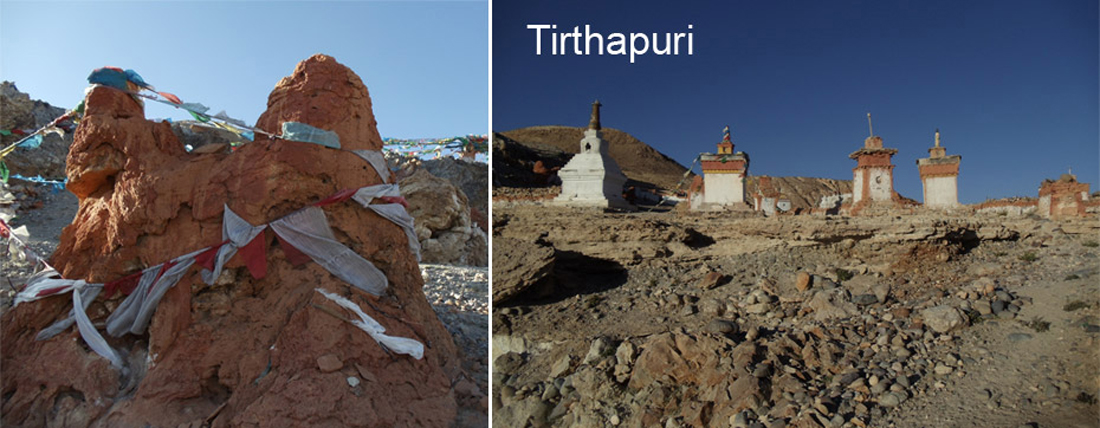 In the west part of Mount Kailash, Tirthapuri is located 70 kilometers from Darchen. From Major village, a distance of 500 meters on the bank of the river Sutlej lies Tirthapuri. Around Tirthapuri, there is no Himalayan mountain range, only red colored dried up mountains, which are beautiful in their own right. According to legend, the demon Bhasmasur was burnt to ashes here in Tirthapuri. Hare meditation was also practiced by the first Tirthankar of the Jain faith. Several hot springs are located in this region that are believed to have healing properties. Tibetans also believe that minerals found here, known as ringers, have special curative properties. Furthermore, it is well known for its powerful healing properties as well as its medical hot springs.
In the west part of Mount Kailash, Tirthapuri is located 70 kilometers from Darchen. From Major village, a distance of 500 meters on the bank of the river Sutlej lies Tirthapuri. Around Tirthapuri, there is no Himalayan mountain range, only red colored dried up mountains, which are beautiful in their own right. According to legend, the demon Bhasmasur was burnt to ashes here in Tirthapuri. Hare meditation was also practiced by the first Tirthankar of the Jain faith. Several hot springs are located in this region that are believed to have healing properties. Tibetans also believe that minerals found here, known as ringers, have special curative properties. Furthermore, it is well known for its powerful healing properties as well as its medical hot springs.
 In Khojarnath, a small village between Taklakot and Hillsa, is an ancient temple of (Monastery type) Shree Ram, Sita and Lakshman. The temple was built in around the 7th century and contains a large gold painted statue of Shree Ram, Sita, and Lakshman. Khojarnath temple is easily accessible by helicopter from Simikot - Hillsa. It is 8KM away by land from Hillsa. From Kathmandu, one can take the plain to Nepalgunj and Nepalgunj to Simikot, and then connect with the helicopter service from Simikot to Hillsa, cross the Nepal Tibet friendship bridge, and drive to Khojarnath village, which is 8 km away. From Manasarovar Lake, it takes 85 kilometers to drive one way and one and a half hours to drive round trip.
In Khojarnath, a small village between Taklakot and Hillsa, is an ancient temple of (Monastery type) Shree Ram, Sita and Lakshman. The temple was built in around the 7th century and contains a large gold painted statue of Shree Ram, Sita, and Lakshman. Khojarnath temple is easily accessible by helicopter from Simikot - Hillsa. It is 8KM away by land from Hillsa. From Kathmandu, one can take the plain to Nepalgunj and Nepalgunj to Simikot, and then connect with the helicopter service from Simikot to Hillsa, cross the Nepal Tibet friendship bridge, and drive to Khojarnath village, which is 8 km away. From Manasarovar Lake, it takes 85 kilometers to drive one way and one and a half hours to drive round trip.
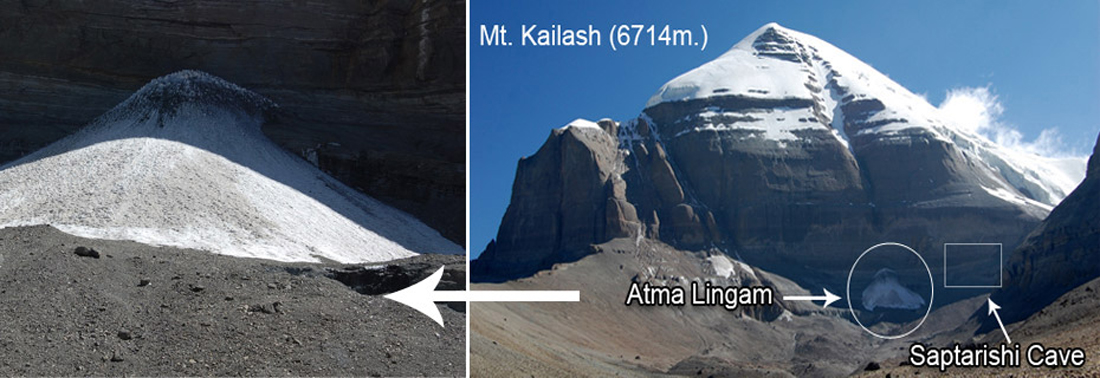 Many Hindu traditions and ancient Purana honor Kailash filled with beautiful, silvery snow-clad mountains, as Shiva's abode. Located on the western side of Kailash, Aruna Mountain contains great pearls, dhatus, and herbal medicines; it is further adorned with Nandi and Ganapati mountains. In his heart, the Atmalinga of Siva shines on the western side of Mount Kailash. It is formed from the snow called pushpadanta, which emanates from Kailash's tip through Ashtapadu. From Atmalingam comes the holy water of sailodha river stream. In Hindu culture, this is the most blessed part of the Mount Kailash and where yogis and Saptarishis (the seven saints) will take holy dips in pious waters to receive lord Shiva's blessing in the form of Jnana (wisdom). (Jnana is a Sanskrit word that means wisdom or knowledge, especially knowledge of oneself).
Many Hindu traditions and ancient Purana honor Kailash filled with beautiful, silvery snow-clad mountains, as Shiva's abode. Located on the western side of Kailash, Aruna Mountain contains great pearls, dhatus, and herbal medicines; it is further adorned with Nandi and Ganapati mountains. In his heart, the Atmalinga of Siva shines on the western side of Mount Kailash. It is formed from the snow called pushpadanta, which emanates from Kailash's tip through Ashtapadu. From Atmalingam comes the holy water of sailodha river stream. In Hindu culture, this is the most blessed part of the Mount Kailash and where yogis and Saptarishis (the seven saints) will take holy dips in pious waters to receive lord Shiva's blessing in the form of Jnana (wisdom). (Jnana is a Sanskrit word that means wisdom or knowledge, especially knowledge of oneself).
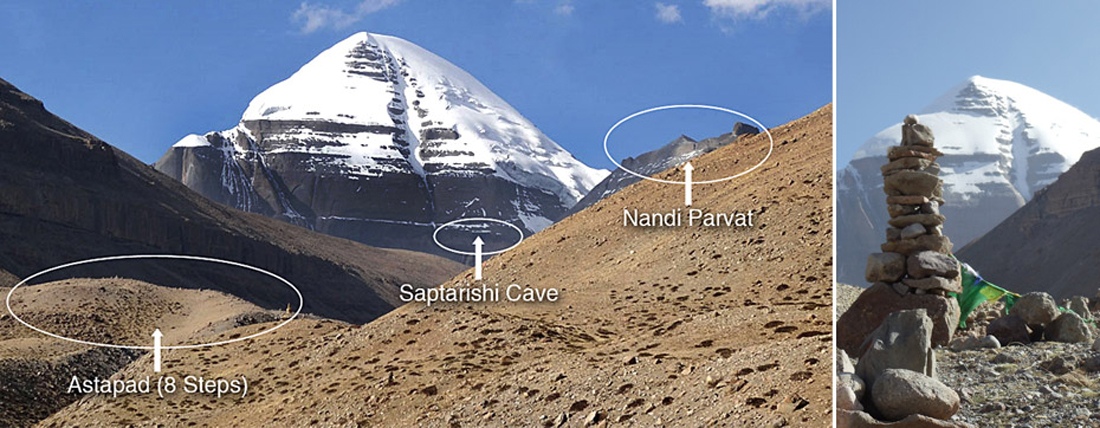 Located just behind Nandi Mountain, Astapad is another sacred mountain near Mount Kailash. Known as the mountain of the eight steps, many saints, Rishis, and monks have meditated in the caves at Astapad. Drive from Darchen to Serlung Monastery, walk up for 10 minutes, visit Astapad, then walk down for 10 minutes and drive back to Darchen. The trip from Darchen takes three hours' round trip.
Located just behind Nandi Mountain, Astapad is another sacred mountain near Mount Kailash. Known as the mountain of the eight steps, many saints, Rishis, and monks have meditated in the caves at Astapad. Drive from Darchen to Serlung Monastery, walk up for 10 minutes, visit Astapad, then walk down for 10 minutes and drive back to Darchen. The trip from Darchen takes three hours' round trip.
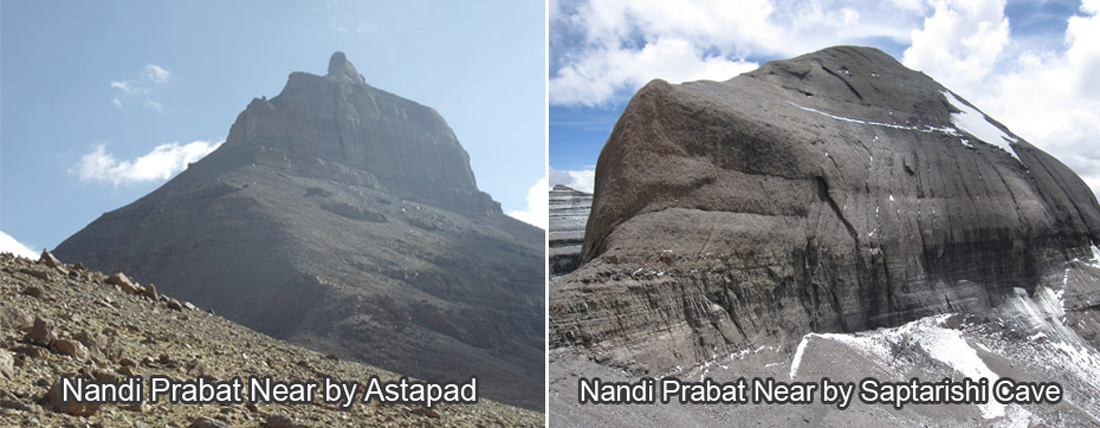 The Nandi Mountain is located in the south part of Kailash and can be reached by Jeep driving from Darchen to Serlung Monastery, then hiking along the shore of the Sailodha river flowing through Darchen and emanating from Mount Kailash. From Darchen, it takes about 10-12 hours' round trip to complete Nandi Parikrama. Atmalingam can also be seen here. It is very steep near Saptarishis cave, so we climb through a climbing rope that our mountain climbing staff assists us with to reach Saptarishis cave. Mount Kailash is at the base camp of Saptarishis cave, which we can also call the base camp for mount Kailash. The altitude of Saptarishis cave is 5700 meters from sea level; after Saptarishis cave, climb up 200 meters and pass hills, and descend the other side very steeply until the end of the hills, and then follow a small river to Serlung monastery.
The Nandi Mountain is located in the south part of Kailash and can be reached by Jeep driving from Darchen to Serlung Monastery, then hiking along the shore of the Sailodha river flowing through Darchen and emanating from Mount Kailash. From Darchen, it takes about 10-12 hours' round trip to complete Nandi Parikrama. Atmalingam can also be seen here. It is very steep near Saptarishis cave, so we climb through a climbing rope that our mountain climbing staff assists us with to reach Saptarishis cave. Mount Kailash is at the base camp of Saptarishis cave, which we can also call the base camp for mount Kailash. The altitude of Saptarishis cave is 5700 meters from sea level; after Saptarishis cave, climb up 200 meters and pass hills, and descend the other side very steeply until the end of the hills, and then follow a small river to Serlung monastery.
Saptarishi Caves are located at an altitude of approximately 5800 meters and are also known to be one of the hardest walking routes in Kailash Manasarovar Yatri. You will be facing a wall that is almost vertical for climbing to the Saptarishi caves once you leave Atmalingam. Mountain guides must use a fixed rope or climbing rope from the bottom of Saptarishi care to Sardung Chuksum La pass.
As per Hindu myth, well-known Rishis and Saints meditated in Saptarishi cave underneath Mount Kailash from where Atmalingam can be seen also. Therefore, it is believed that only physically fit and spiritually pure people are capable of paying homage to this cave and Nandi Parikrama. Mountain guides, masks, regulators, and oxygen bottles are provided by Monterosa Treks and Expeditions. However, this area is now officially closed from 2013 to the present.